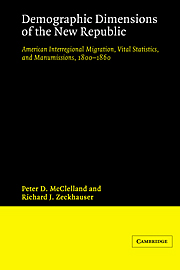 Demographic Dimensions of the New Republic
Demographic Dimensions of the New Republic Book contents
- Frontmatter
- Contents
- List of tables
- Preface
- Map 1 Regions of the United States
- 1 Introduction and summary
- 2 Migration model: closed population
- 3 Migration model: adjustments for international migration
- 4 Interregional migration estimates 1800–60
- 5 White population: birth rates, death rates, and rates of natural increase
- 6 Negro population: birth rates, death rates, rates of natural increase, and manumissions
- 7 Conclusions
- Appendixes
- Notes
- Bibliography
- Index
7 - Conclusions
Published online by Cambridge University Press: 19 September 2009
- Frontmatter
- Contents
- List of tables
- Preface
- Map 1 Regions of the United States
- 1 Introduction and summary
- 2 Migration model: closed population
- 3 Migration model: adjustments for international migration
- 4 Interregional migration estimates 1800–60
- 5 White population: birth rates, death rates, and rates of natural increase
- 6 Negro population: birth rates, death rates, rates of natural increase, and manumissions
- 7 Conclusions
- Appendixes
- Notes
- Bibliography
- Index
Summary
The substantive conclusions of this study have been summarized in chapter 1. The central methodological point deserves further scrutiny because it has been so frequently ignored.
The point concerns the linkage between data accuracy and hypothesis testing. The pioneering work of Conrad and Meyer illustrates the problem. Their primary objective was to measure the profitability of slavery. This required comparing the rate of return from owning slaves with the return available on investment alternatives. Finding the average rate of return for slave owning to range from 4½ to 8 percent and that available on alternative investments to vary between 6 and 8 percent (101), the authors concluded that ‘Slavery was profitable to the whole South.’ (121)
One of several numerical inputs needed to calculate the rate of return from owning slaves is the value of land required per field hand, a number that bulks large in the final calculation. This was apparently derived by Conrad and Meyer from two sources: (a) Lewis Gray's estimate of $35 per acre for a large plantation devoted to upland cotton ‘say, in the Mississippi alluvium’ and (b) the report of a single farmer in Barbour County, Alabama, to The Southern Cultivator in 1846 concerning his operating costs during the previous two years, the relevant entry reading, ‘Say, 360 acres poor pine land at $6 per acre.’
- Type
- Chapter
- Information
- Demographic Dimensions of the New RepublicAmerican Interregional Migration, Vital Statistics and Manumissions 1800-1860, pp. 84 - 86Publisher: Cambridge University PressPrint publication year: 1983


